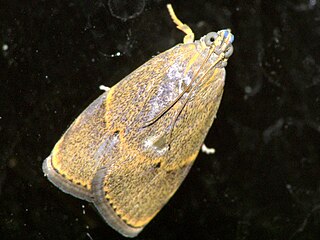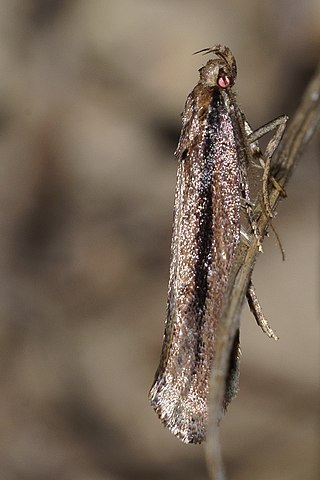Allotelphusa is a monotypic moth genus in the family Gelechiidae erected by Anthonie Johannes Theodorus Janse in 1958. Its only species, Allotelphusa lathridia, was first described by Edward Meyrick in 1909. It is found in Gauteng, South Africa.

Imma mylias is a moth of the family Immidae. It is native to Sri Lanka, India, the Andaman Islands, the Philippines and Taiwan. It is an introduced species in Hawaii.
Imma aulonias is a moth in the family Immidae. It was described by Edward Meyrick in 1906. It is found on the Solomon Islands.
Imma auxobathra is a moth in the family Immidae. It was described by Edward Meyrick in 1906. It is found on Borneo and in Nepal.
Imma cancanopis is a moth in the family Immidae. It was described by Edward Meyrick in 1906. It is found in Colombia and French Guiana.
Imma chasmatica is a moth in the family Immidae. It was described by Edward Meyrick in 1906. It is found in the Indian states of Sikkim and Assam.
Imma chlorosoma is a moth in the family Immidae. It was described by Edward Meyrick in 1906. It is found in Assam, India.
Imma cuneata is a moth in the family Immidae. It was described by Edward Meyrick in 1906. It is found in Brazil and Colombia.
Imma hyphantis is a moth in the family Immidae. It was described by Edward Meyrick in 1906. It is found in Sri Lanka.
Imma metriodoxa is a moth in the family Immidae. It was described by Edward Meyrick in 1906. It is found on Sumbawa in Indonesia.
Imma nephelastra is a moth in the family Immidae. It was described by Edward Meyrick in 1906. It is found on Borneo.
Imma neurota is a moth in the family Immidae. It was described by Edward Meyrick in 1906. It is found on Borneo.
Imma otoptera is a moth in the family Immidae. It was described by Edward Meyrick in 1906. It is found on Borneo.
Imma thyriditis is a moth in the family Immidae. It was described by Edward Meyrick in 1906. It is found on the Solomon Islands.
Imma tyrocnista is a moth in the family Immidae. It was described by Edward Meyrick in 1906. It is found on India's Andaman Islands.
Imma nubigena is a moth in the family Immidae. It was described by Edward Meyrick in 1910. It is found on Bali.
Imma halonitis is a moth in the family Immidae. It was described by Edward Meyrick in 1920. It is found in Chennai, India.
Imma lithosioides is a moth in the family Immidae. It was described by Frederic Moore in 1887. It is found in Sri Lanka.
Imma eriospila is a species of moth in the family Immidae. It was described by Edward Meyrick in 1922. It is found in Pará, Brazil.

Atomotricha versuta is a moth in the family Oecophoridae first described by Edward Meyrick in 1914. It is endemic to New Zealand and has been observed in both the North and South Islands. The adults of the species are variable in appearance but the three principal variteis are connected b intermediate forms. The female of the species is brachypterous and is incapable of flight. Both the adult male and female have been observed resting on fences during cold winter nights.

